Correlation of Feedstock Powder Characteristics with Microstructure, Composition, and Mechanical Properties of La2Ce2O7 Coatings Produced by Plasma Spray-Physical Vapor Deposition
Abstract
1. Introduction
2. Materials and Methods
2.1. Feedstock Fabrication
2.2. Coating Preparation
2.3. Characterization
3. Results and Discussion
3.1. Microstructure and Composition of LC Feedstocks
3.2. Microstructure of LC Coatings
3.3. Composition of LC Coatings
3.4. Nano-Indentation Tests of LC Coatings
4. Conclusions
- (1)
- Small agglomerated feedstock, weak binding strength and small primary particle sizes can enhance the feedstock evaporation rates, thus obtaining well columnar structured coatings. Nevertheless, fine particles can be co-deposition inside the columns if the powder feed rate is too high.
- (2)
- The La/Ce atomic ratios of the coatings reduced compared to those of the feedstocks, especially the coatings with better columnar structure. Thus, to achieve stoichiometric LC coatings with well columnar structure, adding reasonable excess La in the feedstock is necessary.
- (3)
- Both the hardness and Young’s modulus of each coating show negative correlations with the porosity inside the columns. To optimize the hardness and Young’s modulus simultaneously for TBCs utilization, the porosity can be modified by adjusting the powder feed rate.
Author Contributions
Funding
Acknowledgments
Conflicts of Interest
References
- Niessen, K.V.; Gindrat, M.; Refke, A. Vapor phase deposition using plasma spray-PVD. J. Therm. Spray Technol. 2010, 19, 502–509. [Google Scholar] [CrossRef]
- Hospach, A.; Mauer, G.; Vaßen, R.; Stöver, D. Columnar-structured thermal barrier coatings (TBCs) by thin film low-pressure plasma spraying (LPPS-TF). J. Therm. Spray Technol. 2011, 20, 116–120. [Google Scholar] [CrossRef]
- Rezanka, S.; Mauer, G.; Vaßen, R. Improved thermal cycling durability of thermal barrier coatings manufactured by PS-PVD. J. Therm. Spray Technol. 2014, 23, 182–189. [Google Scholar] [CrossRef]
- Gao, L.; Guo, H.; Wei, L.; Li, C.; Xu, H. Microstructure, thermal conductivity and thermal cycling behavior of thermal barrier coatings prepared by plasma spray physical vapor deposition. Surf. Coat. Technol. 2015, 276, 424–430. [Google Scholar] [CrossRef]
- Rezanka, S.; Mack, D.E.; Mauer, G.; Sebold, D.; Guillon, O.; Vaßen, R. Investigation of the resistance of open-column-structured PS-PVD TBCs to erosive and high-temperature corrosive attack. Surf. Coat. Technol. 2017, 324, 222–235. [Google Scholar] [CrossRef]
- He, W.; Mauer, G.; Sohn, Y.J.; Schwedt, A.; Guillon, O.; Vaßen, R. Investigation on growth mechanisms of columnar structured YSZ coatings in Plasma Spray-Physical Vapor Deposition (PS-PVD). J. Eur. Ceram. Soc. 2019, 39, 3129–3138. [Google Scholar] [CrossRef]
- Niessen, K.V.; Gindrat, M. Plasma spray-PVD: A new thermal spray process to deposit out of the vapor phase. J. Therm. Spray Technol. 2011, 20, 736–743. [Google Scholar] [CrossRef]
- Harder, B.J.; Zhu, D.; Schmitt, M.P.; Wolfe, D.E. Microstructural effects and properties of non-line-of-sight coating processing via plasma spray-physical vapor deposition. J. Therm. Spray Technol. 2017, 26, 1052–1061. [Google Scholar] [CrossRef]
- He, W.; Mauer, G.; Gindrat, M.; Wager, R.; Vaßen, R. Investigations on the nature of ceramic deposits in plasma spray-physical vapor deposition. J. Therm. Spray Technol. 2017, 26, 83–92. [Google Scholar] [CrossRef]
- Mauer, G.; Hospach, A.; Vaßen, R. Process development and coating characteristics of plasma spray-PVD. Surf. Coat. Technol. 2013, 220, 219–224. [Google Scholar] [CrossRef]
- Mauer, G.; Jarligo, M.O.; Rezanka, S.; Hospach, A.; Vaßen, R. Novel opportunities for thermal spray by PS-PVD. Surf. Coat. Technol. 2015, 268, 52–57. [Google Scholar] [CrossRef]
- Li, C.; Guo, H.; Gao, L.; Wei, L. Microstructures of yttria-stabilized zirconia coatings by plasma spray-physical vapor deposition. J. Therm. Spray Technol. 2015, 24, 534–541. [Google Scholar] [CrossRef]
- Zhang, B.; Wei, L.; Gao, L.; Guo, H.; Xu, H. Microstructural characterization of PS-PVD ceramic thermal barrier coatings with quasi-columnar structures. Surf. Coat. Technol. 2017, 311, 199–205. [Google Scholar] [CrossRef]
- Zhang, B.; Song, W.; Wei, L.; Xiu, Y.; Xu, H.; Dingwell, D.B.; Guo, H. Novel thermal barrier coatings repel and resist molten silicate deposits. Scr. Mater. 2019, 163, 71–76. [Google Scholar] [CrossRef]
- Thibblin, A.; Jonsson, S.; Olofsson, U. Influence of microstructure on thermal cycling lifetime and thermal insulation properties of yttria-stabilized zirconia thermal barrier coatings for diesel engine applications. Surf. Coat. Technol. 2018, 350, 1–11. [Google Scholar] [CrossRef]
- He, W.; Mauer, G.; Schwedt, A.; Guillon, O.; Vaßen, R. Advanced crystallographic study of the columnar growth of YZS coatings produced by PS-PVD. J. Eur. Ceram. Soc. 2018, 38, 2449–2453. [Google Scholar] [CrossRef]
- Yang, X.; Wei, L.; Li, J.; Zhang, B.; Wang, S.; Guo, H. Microstructural evolution of plasma spray physical vapor deposited thermal barrier coatings at 1150 °C studied by impedance spectroscopy. Ceram. Int. 2018, 44, 10797–10805. [Google Scholar] [CrossRef]
- Padture, N.P.; Gell, M.; Jordan, E.H. Thermal barrier coatings for gas-turbine engine applications. Science 2002, 296, 280–284. [Google Scholar] [CrossRef]
- Miller, R.A. Thermal barrier coatings for aircraft engines: History and directions. J. Therm. Spray Technol. 1997, 6, 35–42. [Google Scholar] [CrossRef]
- Nakanishi, N.; Shigematsu, T. Martensitic transformations in zirconia ceramics. Mater. Trans. JIM 1992, 33, 318–323. [Google Scholar] [CrossRef][Green Version]
- Basu, B.; Vleugels, J.; Van Der Biest, O. Transformation behaviour of tetragonal zirconia: Role of dopant content and distribution. Mater. Sci. Eng. A 2004, 366, 338–347. [Google Scholar] [CrossRef]
- Schulz, U.; Saruhan, B.; Fritscher, K.; Leyens, C. Review on advanced EB-PVD ceramic topcoats for TBC applications. Int. J. Appl. Ceram. Technol. 2004, 1, 302–315. [Google Scholar] [CrossRef]
- Cao, X.; Vaßen, R.; Fischer, W.; Tietz, F.; Jungen, W.; Stover, D. Lanthanum-Cerium Oxide as a thermal barrier-coating material for high-temperature applications. Adv. Mater. 2003, 15, 1438–1442. [Google Scholar] [CrossRef]
- Ma, W.; Gong, S.; Li, H.; Xu, H. Novel thermal barrier coatings based on La2Ce2O7/8YSZ double-ceramic-layer systems deposited by electron beam physical vapor deposition. Surf. Coat. Technol. 2008, 202, 2704–2708. [Google Scholar] [CrossRef]
- Zhao, C.; He, W.; Wei, L.; Guo, H. Microstructures of La2Ce2O7 coatings produced by plasma spray-physical vapor deposition. J. Eur. Ceram. Soc. 2019. [Google Scholar] [CrossRef]
- Jacobson, N.S. Thermodynamic Properties of Some Metal Oxide-Zirconia Systems; NASA Lewis Research Center: Cleveland, OH, USA, 1989. [Google Scholar]
- Wang, L.; Zhang, S.; Liu, T.; Li, C.; Li, C.; Yang, G. Dominant effect of particle size on the CeO2 preferential evaporation during plasma spraying of La2Ce2O7. J. Eur. Ceram. Soc. 2017, 37, 1577–1585. [Google Scholar] [CrossRef]
- Xu, Z.; He, L.; Zhao, Y.; Mu, R.; He, S.; Cao, X. Composition, structure evolution and cyclic oxidation behavior of La2(Zr0.7Ce0.3)2O7 EB-PVD TBCs. J. Alloy Compd. 2010, 491, 729–736. [Google Scholar] [CrossRef]
- Reed, R.C. The Superalloys: Fundamentals and Applications; Cambridge University Press: New York, NY, USA, 2006. [Google Scholar]
- Wang, L.; Zhong, X.; Zhao, Y.; Tao, S.; Zhang, W.; Wang, Y.; Sun, X. Design and optimization of coating structure for the thermal barrier coatings fabricated by atmospheric plasma spraying via finite element method. J. Asian Ceram. Soc. 2014, 2, 102–116. [Google Scholar] [CrossRef]
- Mauer, G.; Vaßen, R. Conditions for nucleation and growth in the substrate boundary layer at plasma spray-physical vapor deposition (PS-PVD). Surf. Coat. Technol. 2018. [Google Scholar] [CrossRef]
- Mauer, G.; Hospach, A.; Zotov, N.; Vaßen, R. Process conditions and microstructures of ceramic coatings by gas phase deposition based on plasma spraying. J. Therm. Spray Technol. 2013, 22, 83–89. [Google Scholar] [CrossRef]
- Liu, M.; Zhang, K.; Zhang, Q.; Zhang, M.; Yang, G.; Li, C.; Li, C. Thermodynamic conditions for cluster formation in supersaturated boundary layer during plasma spray-physical vapor deposition. Appl. Surf. Sci. 2019, 471, 950–959. [Google Scholar] [CrossRef]
- Girshick, S.L.; Chiu, C.P. Homogeneous nucleation of particles from the vapor phase in thermal plasma synthesis. Plasma Chem. Plasma Process. 1989, 9, 355–369. [Google Scholar] [CrossRef]
- Xu, Z.; He, S.; He, L.; Mu, R.; Huang, G.; Cao, X. Novel thermal barrier coatings based on La2(Zr0.7Ce0.3)2O7/8YSZ double-ceramic-layer systems deposited by electron beam physical vapor deposition. J. Alloy Compd. 2011, 509, 4273–4283. [Google Scholar] [CrossRef]
- Lian, J.; Wang, L.; Chen, J.; Sun, K.; Ewing, R.C.; Farmer, J.M.; Boatner, L.A. The order–disorder transition in ion-irradiated pyrochlore. Acta Mater. 2003, 51, 1493–1502. [Google Scholar] [CrossRef]
- Bae, J.S.; Choo, W.K.; Lee, C.H. The crystal structure of ionic conductor LaxCe1−xO2−x/2. J. Eur. Ceram. Soc. 2004, 24, 1291–1294. [Google Scholar]
- Andrievskaya, E.; Kornienko, O.; Sameljuk, A.; Sayir, A. Phase relation studies in the CeO2-La2O3 system at 1100–1500 °C. J. Eur. Ceram. Soc. 2011, 31, 1277–1283. [Google Scholar] [CrossRef]
- Gao, L.; Guo, H.; Wei, L.; Li, C.; Gong, S.; Xu, H. Microstructure and mechanical properties of yttria stabilized zirconia coatings prepared by plasma spray physical vapor deposition. Ceram. Int. 2015, 41, 8305–8311. [Google Scholar] [CrossRef]
- Bakan, E.; Mack, D.E.; Mauer, G.; Mücke, R.; Vaßen, R. Porosity-property relationships of plasma-sprayed Gd2Zr2O7/YSZ thermal barrier coatings. J. Am. Ceram. Soc. 2015, 98, 2647–2654. [Google Scholar] [CrossRef]

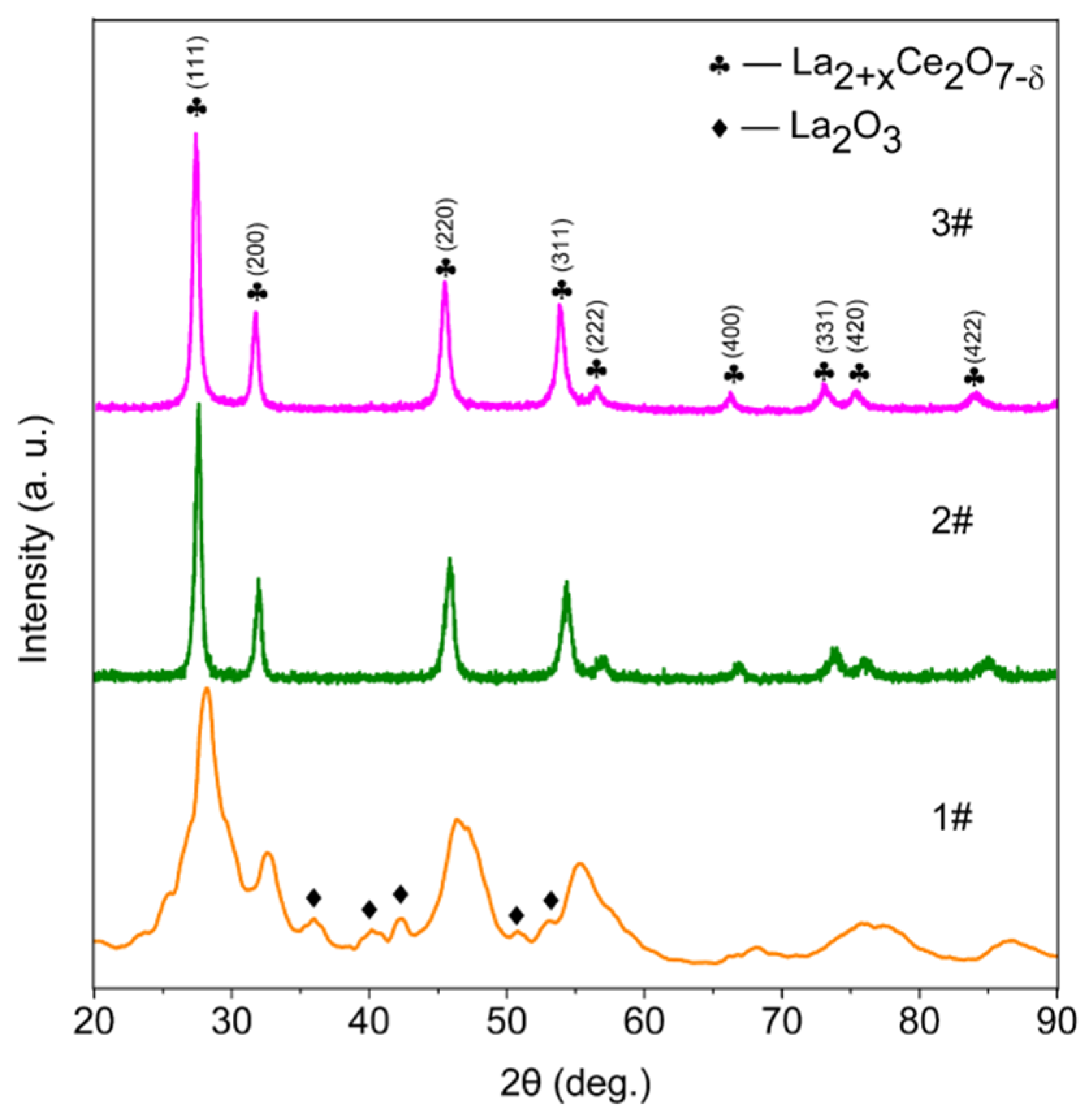
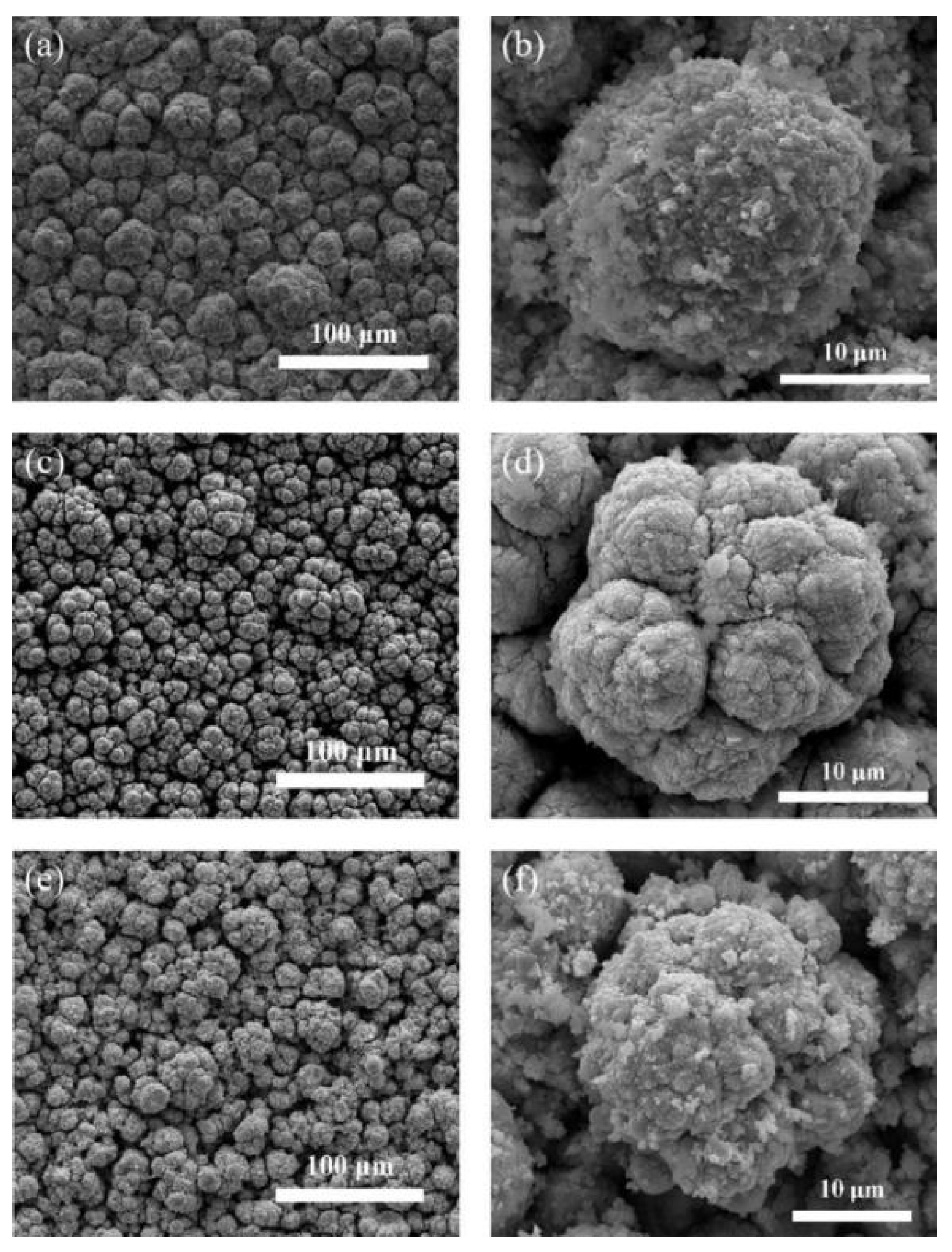
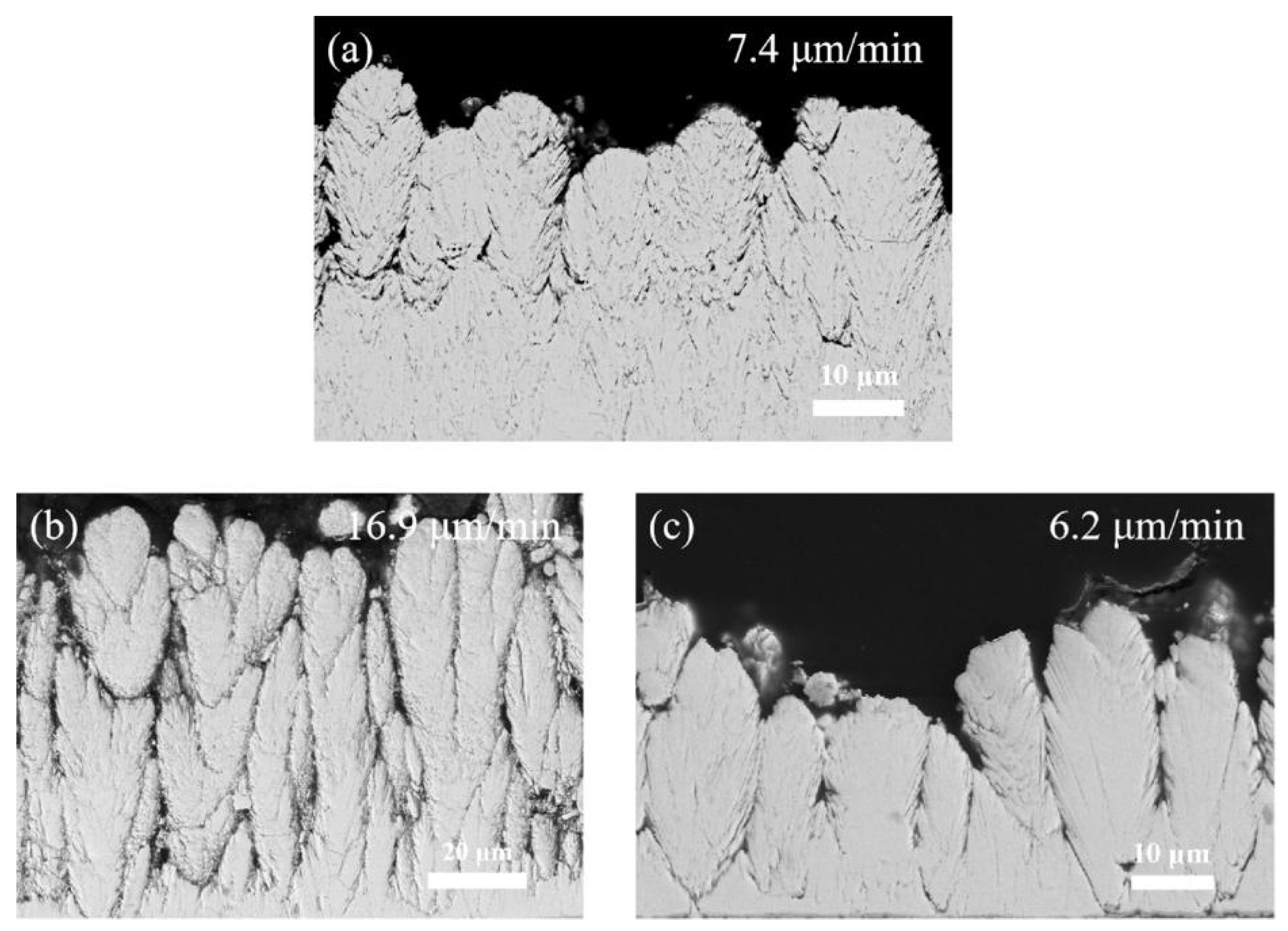
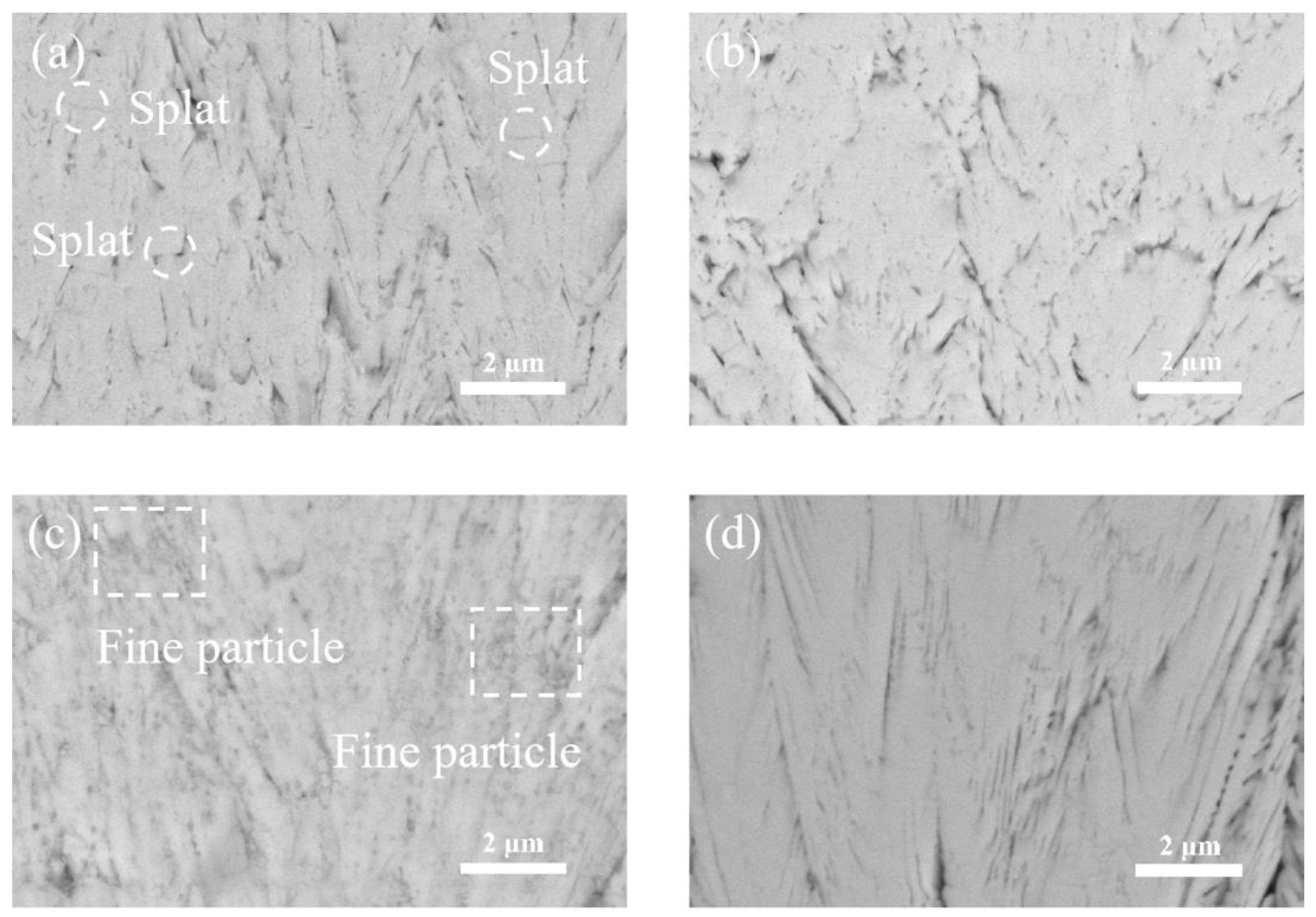
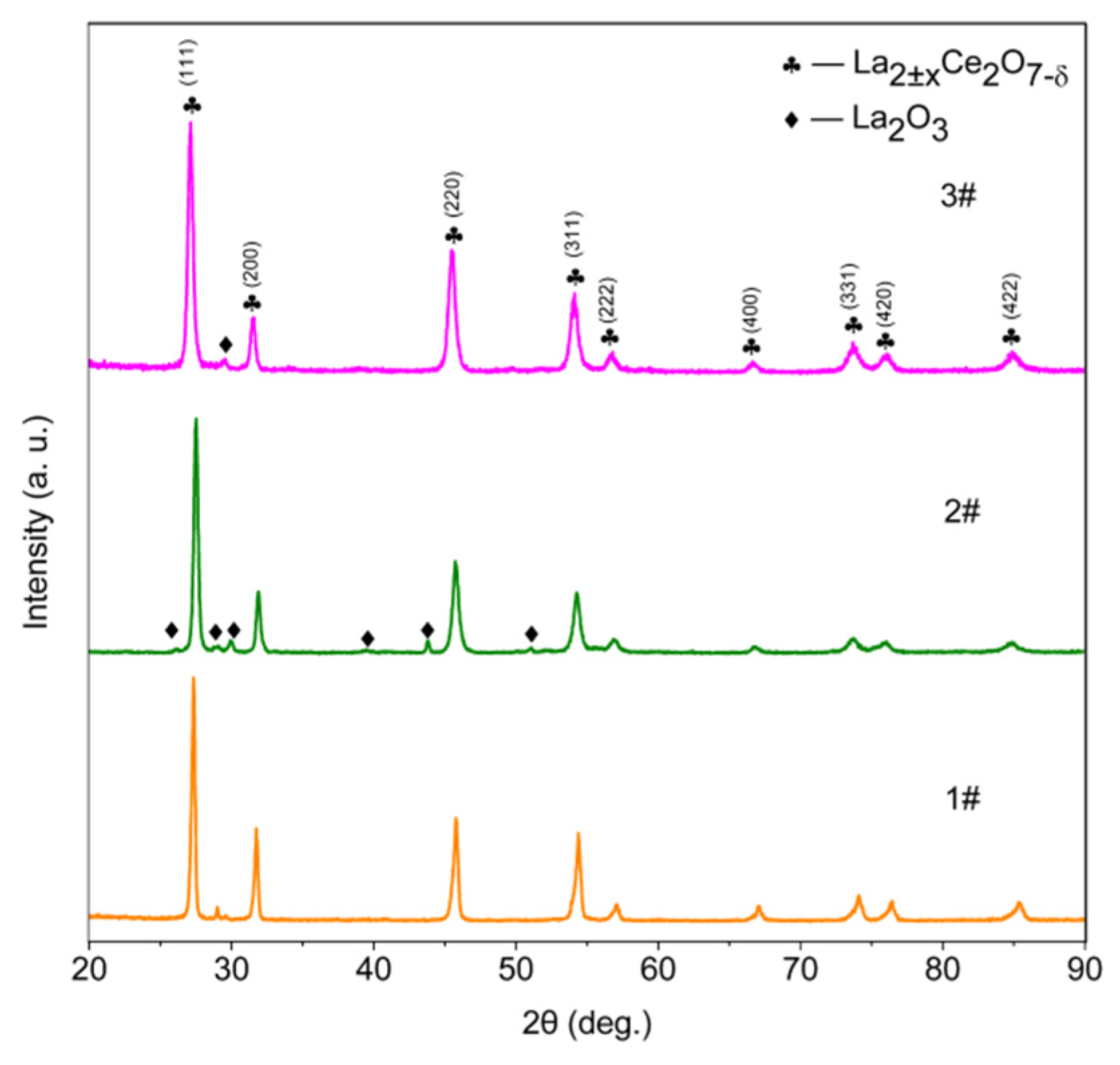

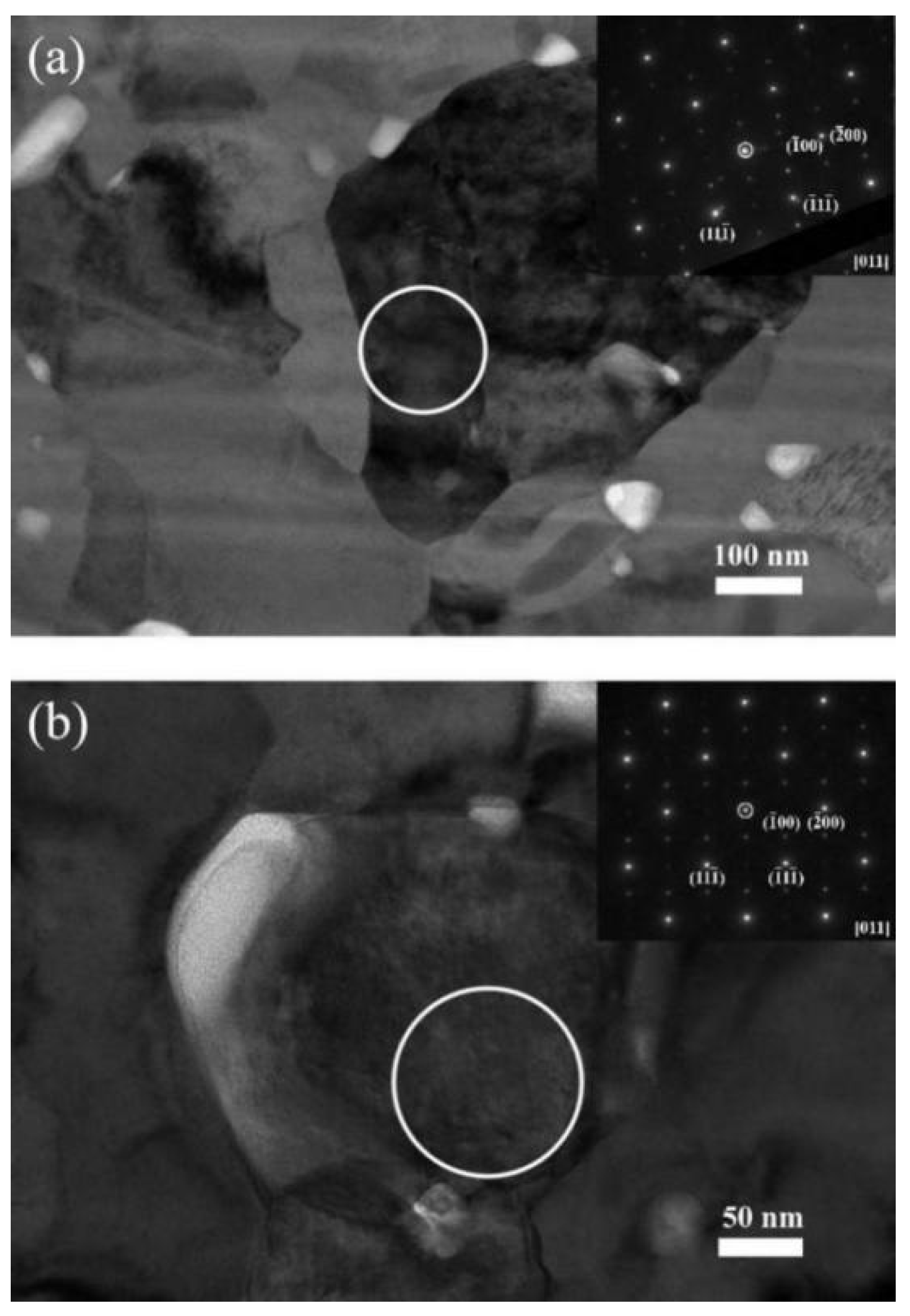
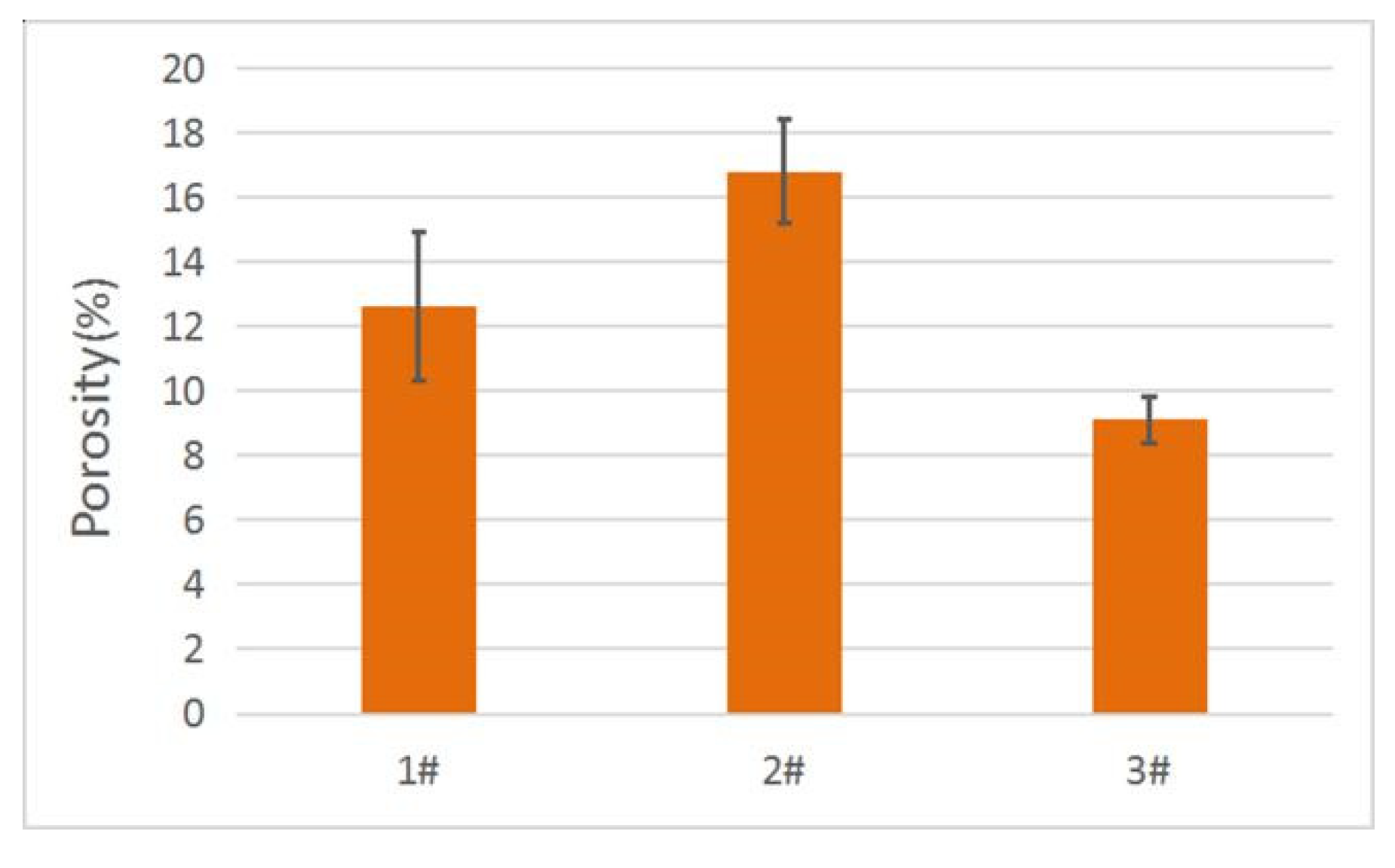
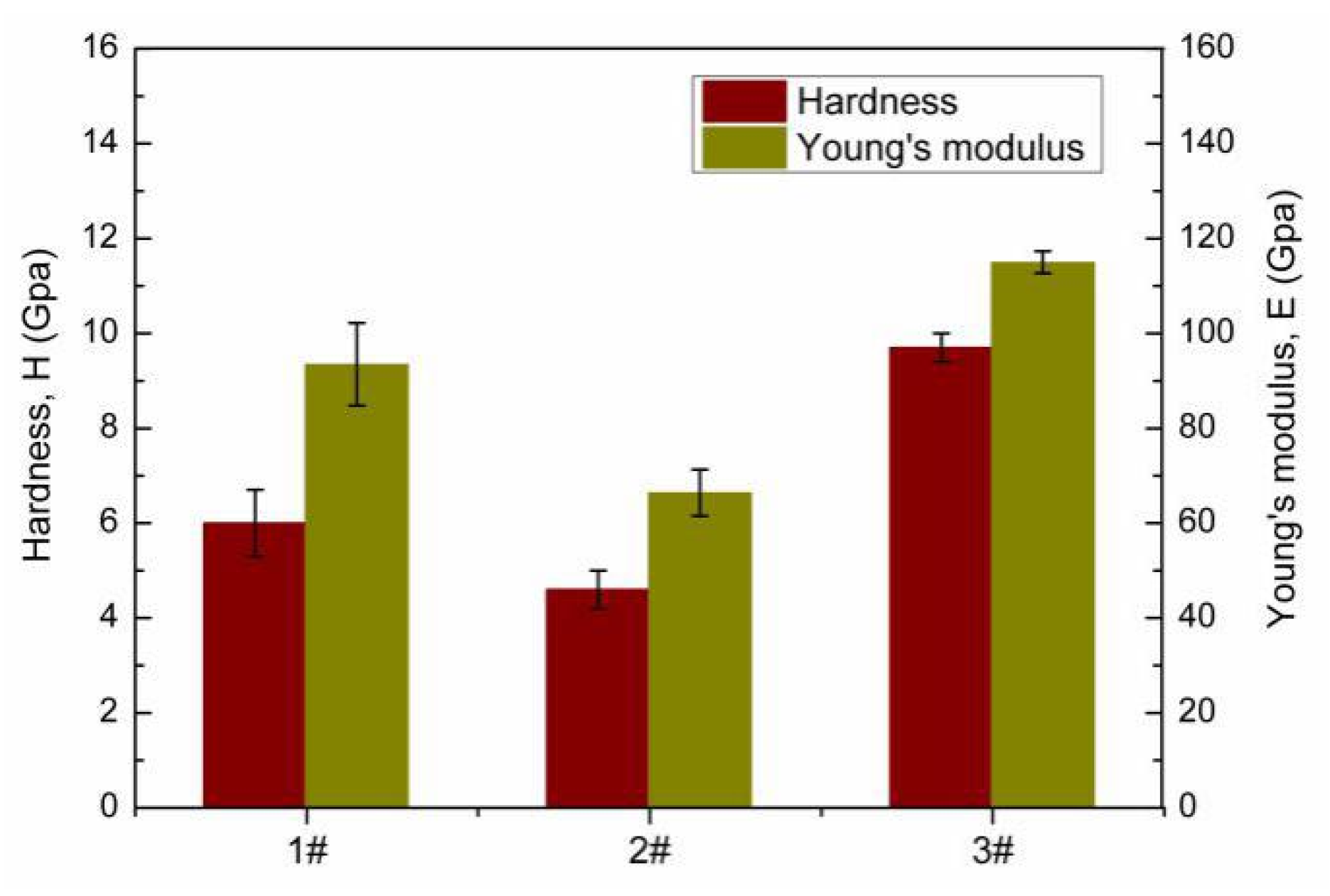
| Powder | Inlet Temperature (°C) | Outlet Temperature (°C) | Nozzle Rotation Speed (r/min) | Slurry Feeding Rate (L/min) |
|---|---|---|---|---|
| 1 | 320 | 120 | 16,000 | 5 |
| 2 | 300 | 100 | 17,000 | 2 |
| 3 | 300 | 100 | 17,000 | 2 |
| Plasma Gas | Ar 30 slpm 1/He 60 slpm 1 |
| Power | 65 kW |
| Chamber pressure | 1 mbar |
| Spray time | 5 min |
| Carrier gas flow | Ar 10 slpm 1 |
| Spray distance | 1000 mm |
| Powder | d10 (μm) | d50 (μm) | d90 (μm) |
|---|---|---|---|
| 1 | 30 | 53 | 80 |
| 1 (after) | 24 | 51 | 73 |
| 2 | 9 | 15 | 25 |
| 2 (after) | 2 | 14 | 23 |
| 3 | 10 | 17 | 27 |
| 3 (after) | 1 | 8 | 23 |
| No. | 1 | 2 | 3 |
|---|---|---|---|
| Powder | 1.24 | 1.11 | 1.48 |
| Coating | 1.17 | 0.77 | 1.19 |
© 2020 by the authors. Licensee MDPI, Basel, Switzerland. This article is an open access article distributed under the terms and conditions of the Creative Commons Attribution (CC BY) license (http://creativecommons.org/licenses/by/4.0/).
Share and Cite
Zhao, C.; He, W.; He, J.; Wei, L.; Guo, H. Correlation of Feedstock Powder Characteristics with Microstructure, Composition, and Mechanical Properties of La2Ce2O7 Coatings Produced by Plasma Spray-Physical Vapor Deposition. Coatings 2020, 10, 93. https://doi.org/10.3390/coatings10020093
Zhao C, He W, He J, Wei L, Guo H. Correlation of Feedstock Powder Characteristics with Microstructure, Composition, and Mechanical Properties of La2Ce2O7 Coatings Produced by Plasma Spray-Physical Vapor Deposition. Coatings. 2020; 10(2):93. https://doi.org/10.3390/coatings10020093
Chicago/Turabian StyleZhao, Cong, Wenting He, Jian He, Liangliang Wei, and Hongbo Guo. 2020. "Correlation of Feedstock Powder Characteristics with Microstructure, Composition, and Mechanical Properties of La2Ce2O7 Coatings Produced by Plasma Spray-Physical Vapor Deposition" Coatings 10, no. 2: 93. https://doi.org/10.3390/coatings10020093
APA StyleZhao, C., He, W., He, J., Wei, L., & Guo, H. (2020). Correlation of Feedstock Powder Characteristics with Microstructure, Composition, and Mechanical Properties of La2Ce2O7 Coatings Produced by Plasma Spray-Physical Vapor Deposition. Coatings, 10(2), 93. https://doi.org/10.3390/coatings10020093






